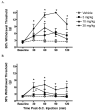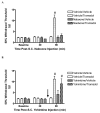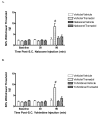Altered antinociceptive efficacy of tramadol over time in rats with painful peripheral neuropathy
- PMID: 17207479
- PMCID: PMC1994250
- DOI: 10.1016/j.ejphar.2006.11.047
Altered antinociceptive efficacy of tramadol over time in rats with painful peripheral neuropathy
Abstract
Pain due to peripheral nerve injury or disease is a dynamic process, such that the mechanism that underlies it alters over time. Tramadol has been reported to be analgesic in clinical neuropathic pain, with varying levels of efficacy due to a patient population that has had neuropathic pain for a wide range of time. In order to address and examine the issue, the antinociceptive efficacy of tramadol over time was tested in rats with a chronic constriction injury (CCI) of the left sciatic nerve. Rats developed a robust hind paw hypersensitivity to innocuous mechanical stimulation ipsilateral to CCI surgery. Subcutaneous injection of tramadol in rats two weeks after CCI surgery dose-dependently attenuated mechanical hypersensitivity, which was abolished with the mu-opioid receptor antagonist naloxone but not the alpha(2)-adrenoceptor antagonist yohimbine. Systemic tramadol also attenuated mechanical hypersensitivity four weeks after CCI surgery, but the efficacy significantly diminished at this time point. In addition, the effect of tramadol at this later time point could be reduced with yohimbine as well as naloxone. These data demonstrate that the efficacy of tramadol depends in part on the duration of nerve injury-evoked nociception, and that its antinociceptive mechanism changes over time. Alteration in antinociceptive mechanism over time may explain the inconsistency in efficacy of this and other analgesic drugs in chronic pain patients.
Figures



Similar articles
-
The effects of dexmedetomidine alone and in combination with tramadol or amitriptyline in a neuropathic pain model.Pain Physician. 2014 Mar-Apr;17(2):187-95. Pain Physician. 2014. PMID: 24658480
-
The antinociceptive effect of tramadol on a model of neuropathic pain in rats.Life Sci. 2000 Mar;66(17):1627-37. doi: 10.1016/s0024-3205(00)00482-3. Life Sci. 2000. PMID: 11261592
-
Analysis of the antinociceptive effect of systemic administration of tramadol and dexmedetomidine combination on rat models of acute and neuropathic pain.Pharmacol Biochem Behav. 2007 Nov;88(1):9-17. doi: 10.1016/j.pbb.2007.06.006. Epub 2007 Jun 28. Pharmacol Biochem Behav. 2007. PMID: 17651791
-
Opioids in neuropathic pain.Curr Pharm Des. 2005;11(23):3013-25. doi: 10.2174/1381612054865055. Curr Pharm Des. 2005. PMID: 16178760 Review.
-
Sigma-1 receptor antagonists: promising players in fighting neuropathic pain.Pharm Pat Anal. 2020 May;9(3):77-85. doi: 10.4155/ppa-2020-0007. Epub 2020 Jun 16. Pharm Pat Anal. 2020. PMID: 32539668 Review.
Cited by
-
Efficacy-Based Perspective to Overcome Reduced Opioid Analgesia of Advanced Painful Diabetic Neuropathy in Rats.Front Pharmacol. 2019 Apr 9;10:347. doi: 10.3389/fphar.2019.00347. eCollection 2019. Front Pharmacol. 2019. PMID: 31024314 Free PMC article.
-
Attenuation of SCI-Induced Hypersensitivity by Intensive Locomotor Training and Recombinant GABAergic Cells.Bioengineering (Basel). 2023 Jan 9;10(1):84. doi: 10.3390/bioengineering10010084. Bioengineering (Basel). 2023. PMID: 36671656 Free PMC article.
-
Effects of tramadol on substantia gelatinosa neurons in the rat spinal cord: an in vivo patch-clamp analysis.PLoS One. 2015 May 1;10(5):e0125147. doi: 10.1371/journal.pone.0125147. eCollection 2015. PLoS One. 2015. PMID: 25933213 Free PMC article.
-
Combination Drug Therapy for Pain following Chronic Spinal Cord Injury.Pain Res Treat. 2012;2012:840486. doi: 10.1155/2012/840486. Epub 2012 Mar 18. Pain Res Treat. 2012. PMID: 22550581 Free PMC article.
-
Intraperitoneal administration of lidocaine or tramadol alone or in combination on postoperative pain after ovariohysterectomy in dogs.Vet Med Sci. 2021 May;7(3):634-641. doi: 10.1002/vms3.437. Epub 2021 Feb 2. Vet Med Sci. 2021. PMID: 33528116 Free PMC article.
References
-
- Alhashemi JA, Kaki AM. Effect of intrathecal tramadol administration on postoperative pain after transurethral resection of prostate. Br. J. Anaesth. 2003;91:536–540. - PubMed
-
- Apaydin S, Uyar M, Karabay NU, Erhan E, Yegul I, Tuglular I. The antinociceptive effect of tramadol on a model of neuropathic pain in rats. Life Sci. 2000;66:1627–1637. - PubMed
-
- Bailey CP, Connor M. Opioids: cellular mechanisms of tolerance and physical dependence. Curr. Opin. Pharmacol. 2005;5:60–68. - PubMed
-
- Bennett GJ, Xie YK. A peripheral mononeuropathy in rat that produces disorders of pain sensation like those seen in man. Pain. 1988;33:87–107. - PubMed
-
- Bernatzky G, Jurna I. Intrathecal injection of codeine, buprenorphine, tilidine, tramadol and nefopam depresses the tail-flick response in rats. Eur. J. Pharmacol. 1986;120:75–80. - PubMed
Publication types
MeSH terms
Substances
Grants and funding
LinkOut - more resources
Full Text Sources
Medical
Research Materials

